Detailed Business Strategy Analysis: Royal Bank of Scotland Report
VerifiedAdded on 2023/01/13
|17
|4715
|1
Report
AI Summary
This report provides a comprehensive analysis of the business strategy of Royal Bank of Scotland (RBS). It begins with an executive summary highlighting the importance of using internal and external environmental models like PESTLE, SWOT, and Porter's 5 forces to analyze factors impacting comp...
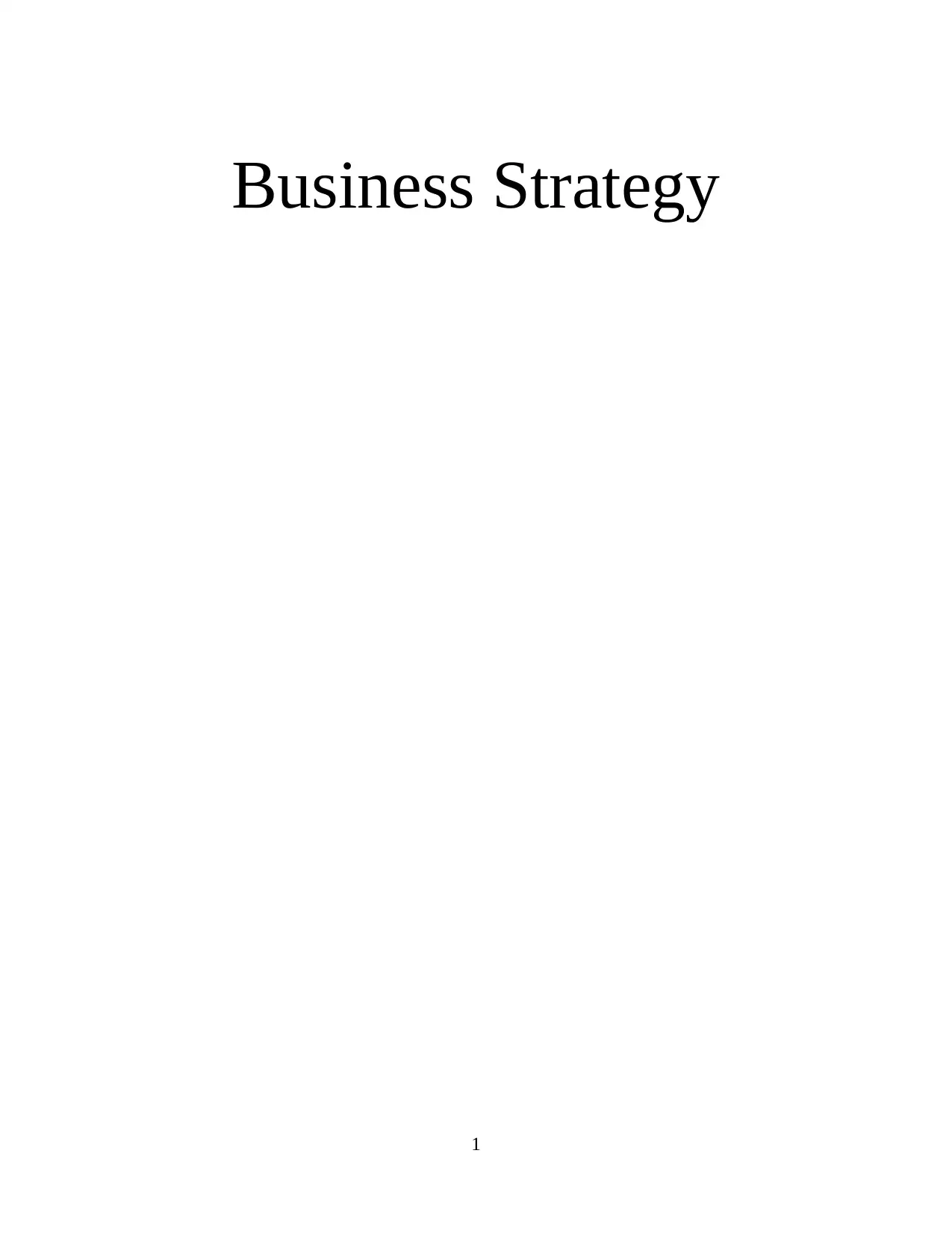
Business Strategy
1
1
Paraphrase This Document
Need a fresh take? Get an instant paraphrase of this document with our AI Paraphraser
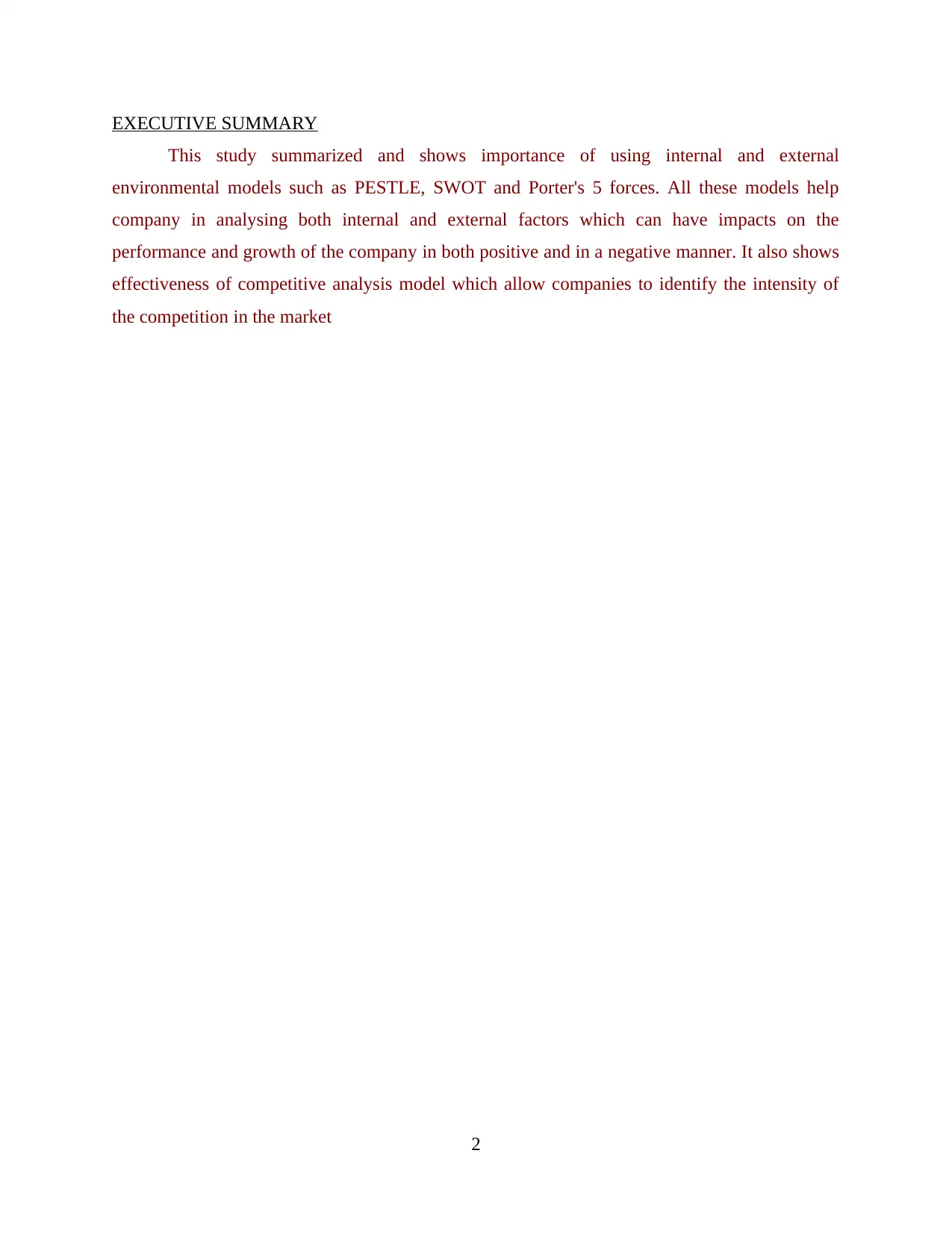
EXECUTIVE SUMMARY
This study summarized and shows importance of using internal and external
environmental models such as PESTLE, SWOT and Porter's 5 forces. All these models help
company in analysing both internal and external factors which can have impacts on the
performance and growth of the company in both positive and in a negative manner. It also shows
effectiveness of competitive analysis model which allow companies to identify the intensity of
the competition in the market
2
This study summarized and shows importance of using internal and external
environmental models such as PESTLE, SWOT and Porter's 5 forces. All these models help
company in analysing both internal and external factors which can have impacts on the
performance and growth of the company in both positive and in a negative manner. It also shows
effectiveness of competitive analysis model which allow companies to identify the intensity of
the competition in the market
2
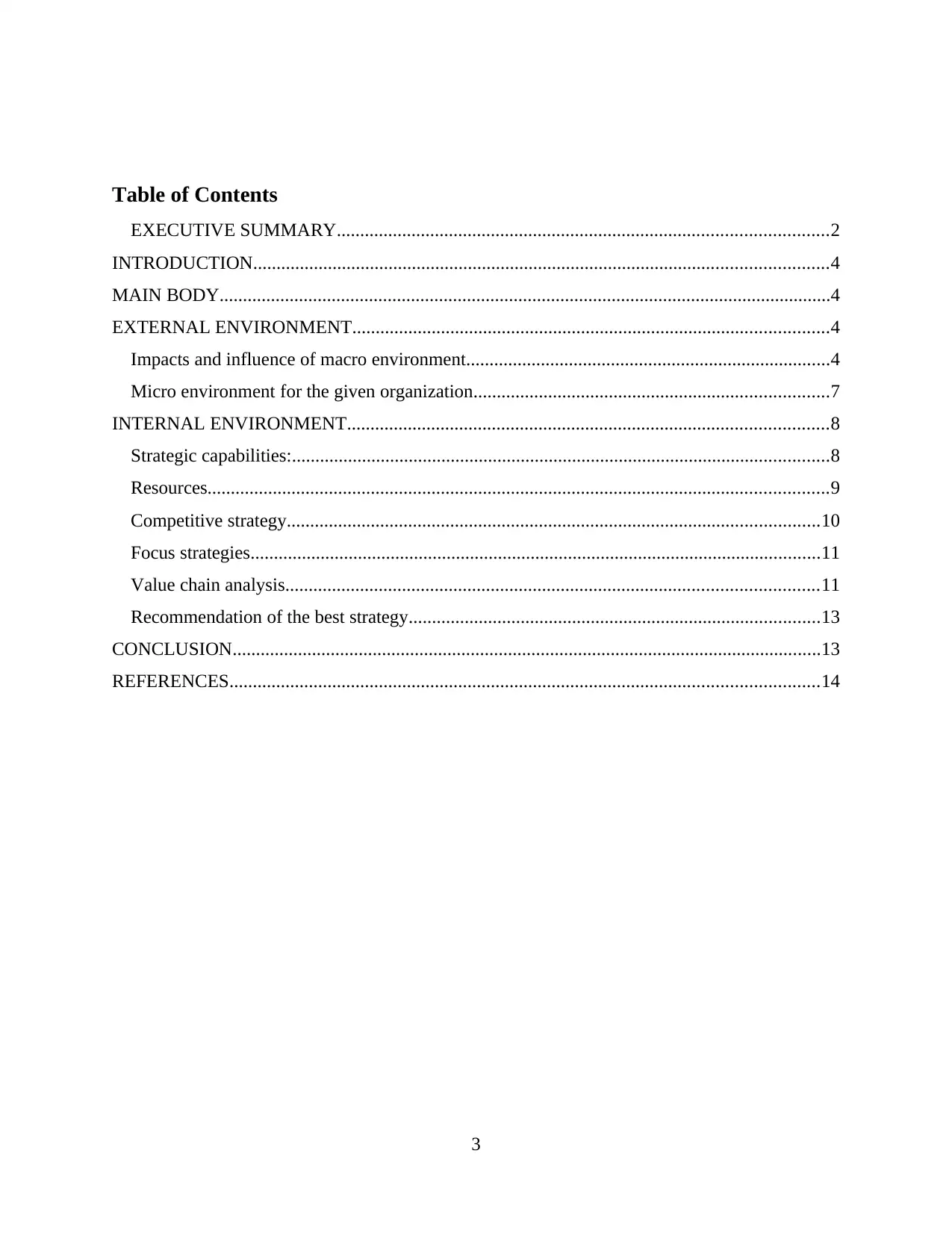
Table of Contents
EXECUTIVE SUMMARY.........................................................................................................2
INTRODUCTION...........................................................................................................................4
MAIN BODY...................................................................................................................................4
EXTERNAL ENVIRONMENT......................................................................................................4
Impacts and influence of macro environment..............................................................................4
Micro environment for the given organization............................................................................7
INTERNAL ENVIRONMENT.......................................................................................................8
Strategic capabilities:...................................................................................................................8
Resources.....................................................................................................................................9
Competitive strategy..................................................................................................................10
Focus strategies..........................................................................................................................11
Value chain analysis..................................................................................................................11
Recommendation of the best strategy........................................................................................13
CONCLUSION..............................................................................................................................13
REFERENCES..............................................................................................................................14
3
EXECUTIVE SUMMARY.........................................................................................................2
INTRODUCTION...........................................................................................................................4
MAIN BODY...................................................................................................................................4
EXTERNAL ENVIRONMENT......................................................................................................4
Impacts and influence of macro environment..............................................................................4
Micro environment for the given organization............................................................................7
INTERNAL ENVIRONMENT.......................................................................................................8
Strategic capabilities:...................................................................................................................8
Resources.....................................................................................................................................9
Competitive strategy..................................................................................................................10
Focus strategies..........................................................................................................................11
Value chain analysis..................................................................................................................11
Recommendation of the best strategy........................................................................................13
CONCLUSION..............................................................................................................................13
REFERENCES..............................................................................................................................14
3
⊘ This is a preview!⊘
Do you want full access?
Subscribe today to unlock all pages.

Trusted by 1+ million students worldwide
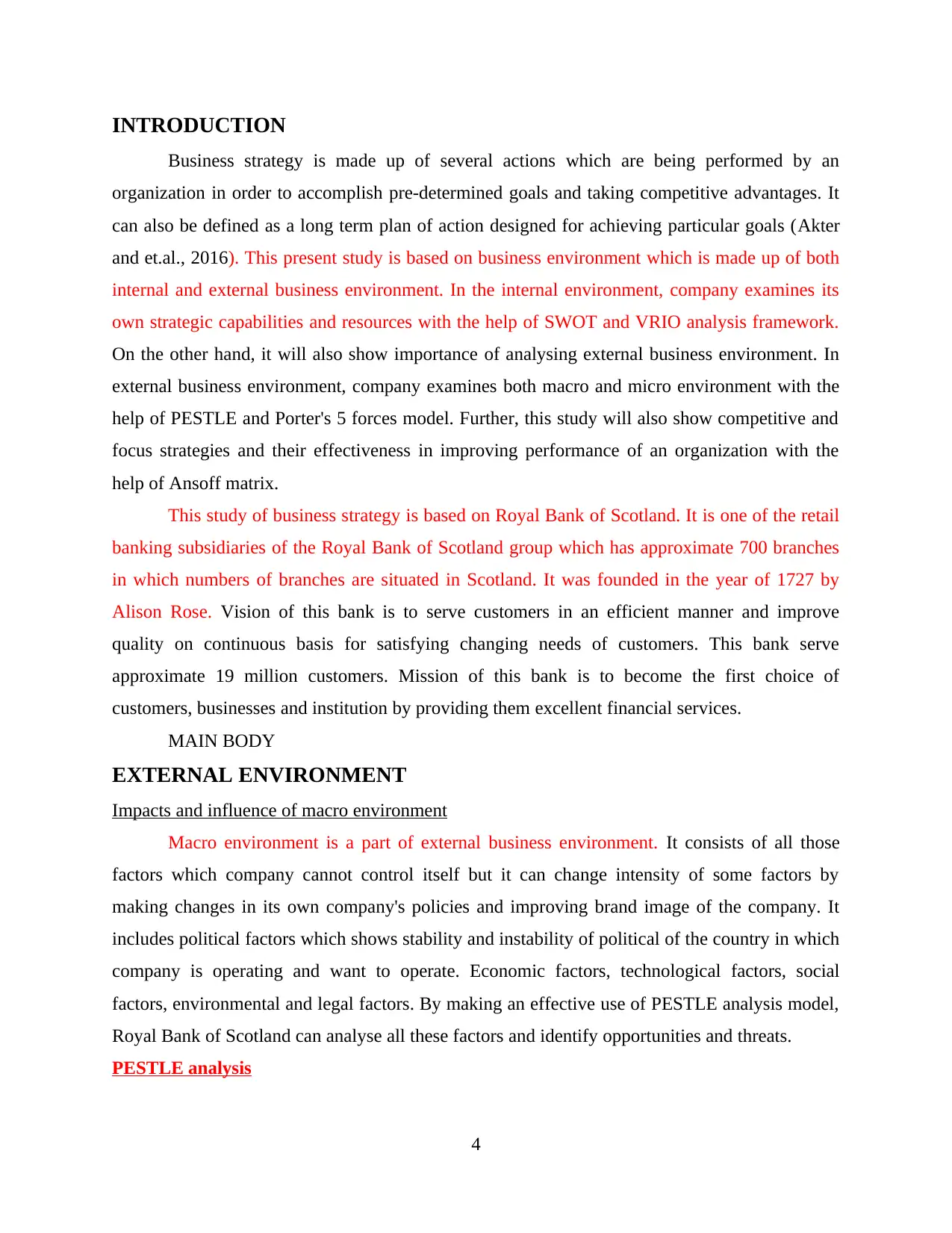
INTRODUCTION
Business strategy is made up of several actions which are being performed by an
organization in order to accomplish pre-determined goals and taking competitive advantages. It
can also be defined as a long term plan of action designed for achieving particular goals (Akter
and et.al., 2016). This present study is based on business environment which is made up of both
internal and external business environment. In the internal environment, company examines its
own strategic capabilities and resources with the help of SWOT and VRIO analysis framework.
On the other hand, it will also show importance of analysing external business environment. In
external business environment, company examines both macro and micro environment with the
help of PESTLE and Porter's 5 forces model. Further, this study will also show competitive and
focus strategies and their effectiveness in improving performance of an organization with the
help of Ansoff matrix.
This study of business strategy is based on Royal Bank of Scotland. It is one of the retail
banking subsidiaries of the Royal Bank of Scotland group which has approximate 700 branches
in which numbers of branches are situated in Scotland. It was founded in the year of 1727 by
Alison Rose. Vision of this bank is to serve customers in an efficient manner and improve
quality on continuous basis for satisfying changing needs of customers. This bank serve
approximate 19 million customers. Mission of this bank is to become the first choice of
customers, businesses and institution by providing them excellent financial services.
MAIN BODY
EXTERNAL ENVIRONMENT
Impacts and influence of macro environment
Macro environment is a part of external business environment. It consists of all those
factors which company cannot control itself but it can change intensity of some factors by
making changes in its own company's policies and improving brand image of the company. It
includes political factors which shows stability and instability of political of the country in which
company is operating and want to operate. Economic factors, technological factors, social
factors, environmental and legal factors. By making an effective use of PESTLE analysis model,
Royal Bank of Scotland can analyse all these factors and identify opportunities and threats.
PESTLE analysis
4
Business strategy is made up of several actions which are being performed by an
organization in order to accomplish pre-determined goals and taking competitive advantages. It
can also be defined as a long term plan of action designed for achieving particular goals (Akter
and et.al., 2016). This present study is based on business environment which is made up of both
internal and external business environment. In the internal environment, company examines its
own strategic capabilities and resources with the help of SWOT and VRIO analysis framework.
On the other hand, it will also show importance of analysing external business environment. In
external business environment, company examines both macro and micro environment with the
help of PESTLE and Porter's 5 forces model. Further, this study will also show competitive and
focus strategies and their effectiveness in improving performance of an organization with the
help of Ansoff matrix.
This study of business strategy is based on Royal Bank of Scotland. It is one of the retail
banking subsidiaries of the Royal Bank of Scotland group which has approximate 700 branches
in which numbers of branches are situated in Scotland. It was founded in the year of 1727 by
Alison Rose. Vision of this bank is to serve customers in an efficient manner and improve
quality on continuous basis for satisfying changing needs of customers. This bank serve
approximate 19 million customers. Mission of this bank is to become the first choice of
customers, businesses and institution by providing them excellent financial services.
MAIN BODY
EXTERNAL ENVIRONMENT
Impacts and influence of macro environment
Macro environment is a part of external business environment. It consists of all those
factors which company cannot control itself but it can change intensity of some factors by
making changes in its own company's policies and improving brand image of the company. It
includes political factors which shows stability and instability of political of the country in which
company is operating and want to operate. Economic factors, technological factors, social
factors, environmental and legal factors. By making an effective use of PESTLE analysis model,
Royal Bank of Scotland can analyse all these factors and identify opportunities and threats.
PESTLE analysis
4
Paraphrase This Document
Need a fresh take? Get an instant paraphrase of this document with our AI Paraphraser
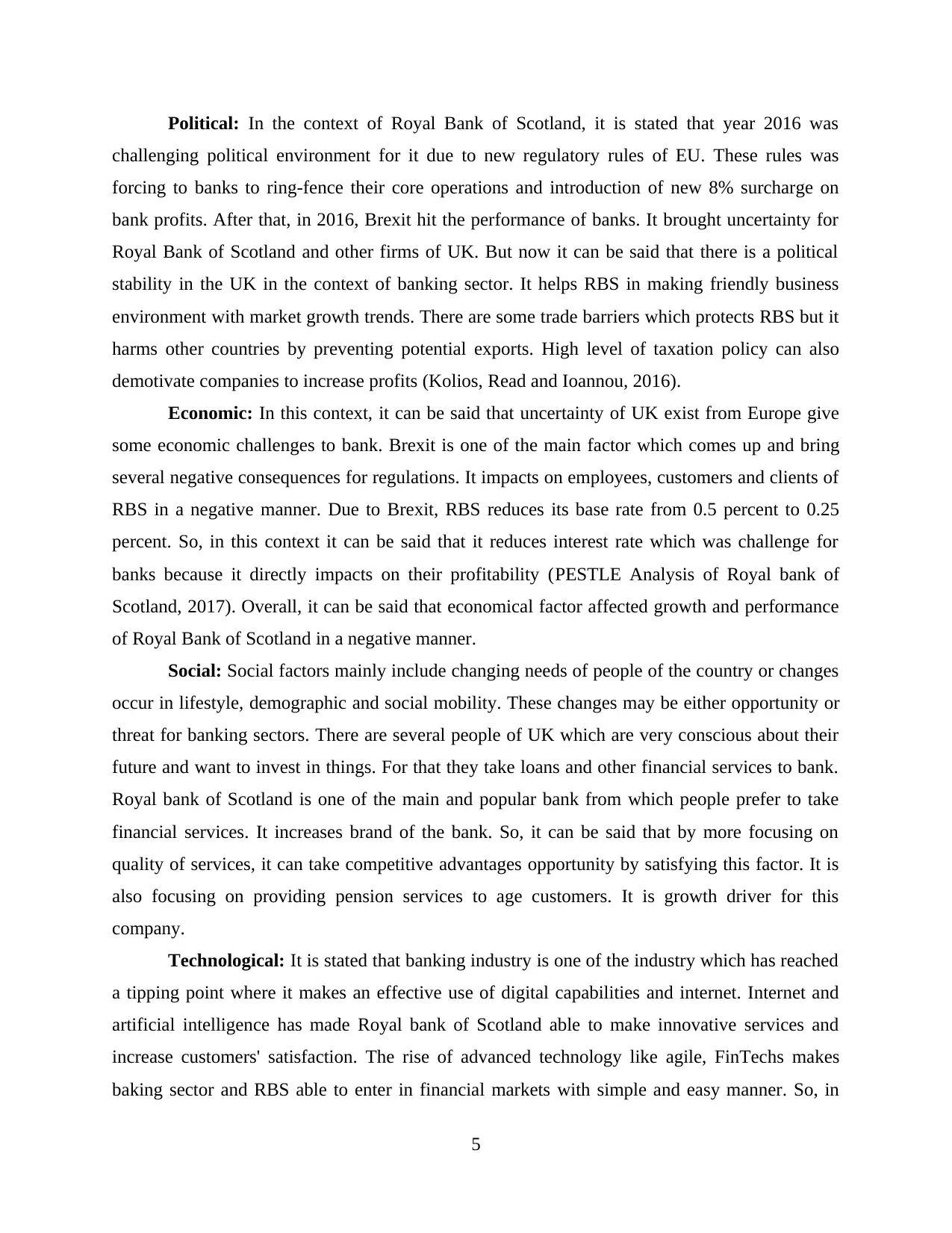
Political: In the context of Royal Bank of Scotland, it is stated that year 2016 was
challenging political environment for it due to new regulatory rules of EU. These rules was
forcing to banks to ring-fence their core operations and introduction of new 8% surcharge on
bank profits. After that, in 2016, Brexit hit the performance of banks. It brought uncertainty for
Royal Bank of Scotland and other firms of UK. But now it can be said that there is a political
stability in the UK in the context of banking sector. It helps RBS in making friendly business
environment with market growth trends. There are some trade barriers which protects RBS but it
harms other countries by preventing potential exports. High level of taxation policy can also
demotivate companies to increase profits (Kolios, Read and Ioannou, 2016).
Economic: In this context, it can be said that uncertainty of UK exist from Europe give
some economic challenges to bank. Brexit is one of the main factor which comes up and bring
several negative consequences for regulations. It impacts on employees, customers and clients of
RBS in a negative manner. Due to Brexit, RBS reduces its base rate from 0.5 percent to 0.25
percent. So, in this context it can be said that it reduces interest rate which was challenge for
banks because it directly impacts on their profitability (PESTLE Analysis of Royal bank of
Scotland, 2017). Overall, it can be said that economical factor affected growth and performance
of Royal Bank of Scotland in a negative manner.
Social: Social factors mainly include changing needs of people of the country or changes
occur in lifestyle, demographic and social mobility. These changes may be either opportunity or
threat for banking sectors. There are several people of UK which are very conscious about their
future and want to invest in things. For that they take loans and other financial services to bank.
Royal bank of Scotland is one of the main and popular bank from which people prefer to take
financial services. It increases brand of the bank. So, it can be said that by more focusing on
quality of services, it can take competitive advantages opportunity by satisfying this factor. It is
also focusing on providing pension services to age customers. It is growth driver for this
company.
Technological: It is stated that banking industry is one of the industry which has reached
a tipping point where it makes an effective use of digital capabilities and internet. Internet and
artificial intelligence has made Royal bank of Scotland able to make innovative services and
increase customers' satisfaction. The rise of advanced technology like agile, FinTechs makes
baking sector and RBS able to enter in financial markets with simple and easy manner. So, in
5
challenging political environment for it due to new regulatory rules of EU. These rules was
forcing to banks to ring-fence their core operations and introduction of new 8% surcharge on
bank profits. After that, in 2016, Brexit hit the performance of banks. It brought uncertainty for
Royal Bank of Scotland and other firms of UK. But now it can be said that there is a political
stability in the UK in the context of banking sector. It helps RBS in making friendly business
environment with market growth trends. There are some trade barriers which protects RBS but it
harms other countries by preventing potential exports. High level of taxation policy can also
demotivate companies to increase profits (Kolios, Read and Ioannou, 2016).
Economic: In this context, it can be said that uncertainty of UK exist from Europe give
some economic challenges to bank. Brexit is one of the main factor which comes up and bring
several negative consequences for regulations. It impacts on employees, customers and clients of
RBS in a negative manner. Due to Brexit, RBS reduces its base rate from 0.5 percent to 0.25
percent. So, in this context it can be said that it reduces interest rate which was challenge for
banks because it directly impacts on their profitability (PESTLE Analysis of Royal bank of
Scotland, 2017). Overall, it can be said that economical factor affected growth and performance
of Royal Bank of Scotland in a negative manner.
Social: Social factors mainly include changing needs of people of the country or changes
occur in lifestyle, demographic and social mobility. These changes may be either opportunity or
threat for banking sectors. There are several people of UK which are very conscious about their
future and want to invest in things. For that they take loans and other financial services to bank.
Royal bank of Scotland is one of the main and popular bank from which people prefer to take
financial services. It increases brand of the bank. So, it can be said that by more focusing on
quality of services, it can take competitive advantages opportunity by satisfying this factor. It is
also focusing on providing pension services to age customers. It is growth driver for this
company.
Technological: It is stated that banking industry is one of the industry which has reached
a tipping point where it makes an effective use of digital capabilities and internet. Internet and
artificial intelligence has made Royal bank of Scotland able to make innovative services and
increase customers' satisfaction. The rise of advanced technology like agile, FinTechs makes
baking sector and RBS able to enter in financial markets with simple and easy manner. So, in
5
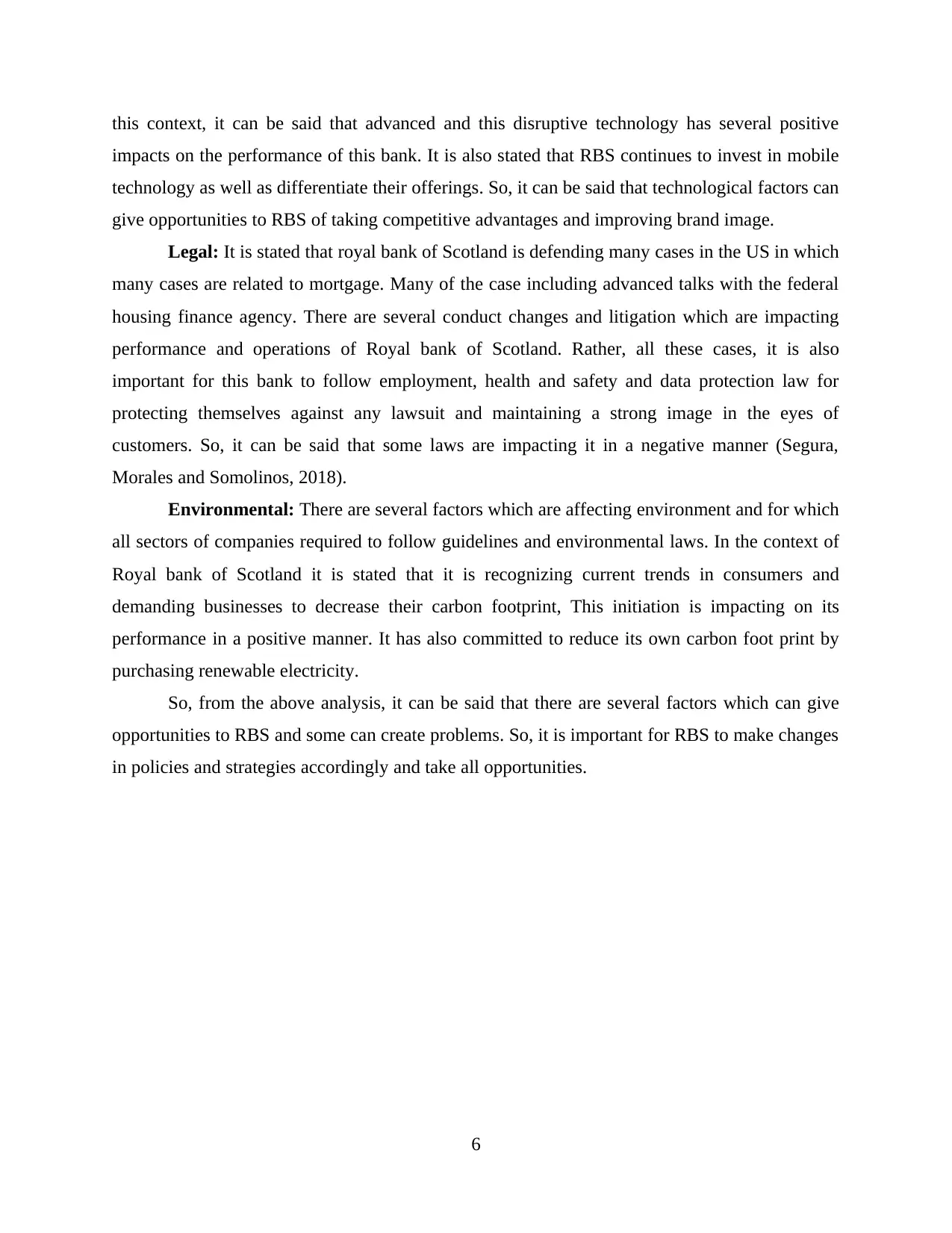
this context, it can be said that advanced and this disruptive technology has several positive
impacts on the performance of this bank. It is also stated that RBS continues to invest in mobile
technology as well as differentiate their offerings. So, it can be said that technological factors can
give opportunities to RBS of taking competitive advantages and improving brand image.
Legal: It is stated that royal bank of Scotland is defending many cases in the US in which
many cases are related to mortgage. Many of the case including advanced talks with the federal
housing finance agency. There are several conduct changes and litigation which are impacting
performance and operations of Royal bank of Scotland. Rather, all these cases, it is also
important for this bank to follow employment, health and safety and data protection law for
protecting themselves against any lawsuit and maintaining a strong image in the eyes of
customers. So, it can be said that some laws are impacting it in a negative manner (Segura,
Morales and Somolinos, 2018).
Environmental: There are several factors which are affecting environment and for which
all sectors of companies required to follow guidelines and environmental laws. In the context of
Royal bank of Scotland it is stated that it is recognizing current trends in consumers and
demanding businesses to decrease their carbon footprint, This initiation is impacting on its
performance in a positive manner. It has also committed to reduce its own carbon foot print by
purchasing renewable electricity.
So, from the above analysis, it can be said that there are several factors which can give
opportunities to RBS and some can create problems. So, it is important for RBS to make changes
in policies and strategies accordingly and take all opportunities.
6
impacts on the performance of this bank. It is also stated that RBS continues to invest in mobile
technology as well as differentiate their offerings. So, it can be said that technological factors can
give opportunities to RBS of taking competitive advantages and improving brand image.
Legal: It is stated that royal bank of Scotland is defending many cases in the US in which
many cases are related to mortgage. Many of the case including advanced talks with the federal
housing finance agency. There are several conduct changes and litigation which are impacting
performance and operations of Royal bank of Scotland. Rather, all these cases, it is also
important for this bank to follow employment, health and safety and data protection law for
protecting themselves against any lawsuit and maintaining a strong image in the eyes of
customers. So, it can be said that some laws are impacting it in a negative manner (Segura,
Morales and Somolinos, 2018).
Environmental: There are several factors which are affecting environment and for which
all sectors of companies required to follow guidelines and environmental laws. In the context of
Royal bank of Scotland it is stated that it is recognizing current trends in consumers and
demanding businesses to decrease their carbon footprint, This initiation is impacting on its
performance in a positive manner. It has also committed to reduce its own carbon foot print by
purchasing renewable electricity.
So, from the above analysis, it can be said that there are several factors which can give
opportunities to RBS and some can create problems. So, it is important for RBS to make changes
in policies and strategies accordingly and take all opportunities.
6
⊘ This is a preview!⊘
Do you want full access?
Subscribe today to unlock all pages.

Trusted by 1+ million students worldwide
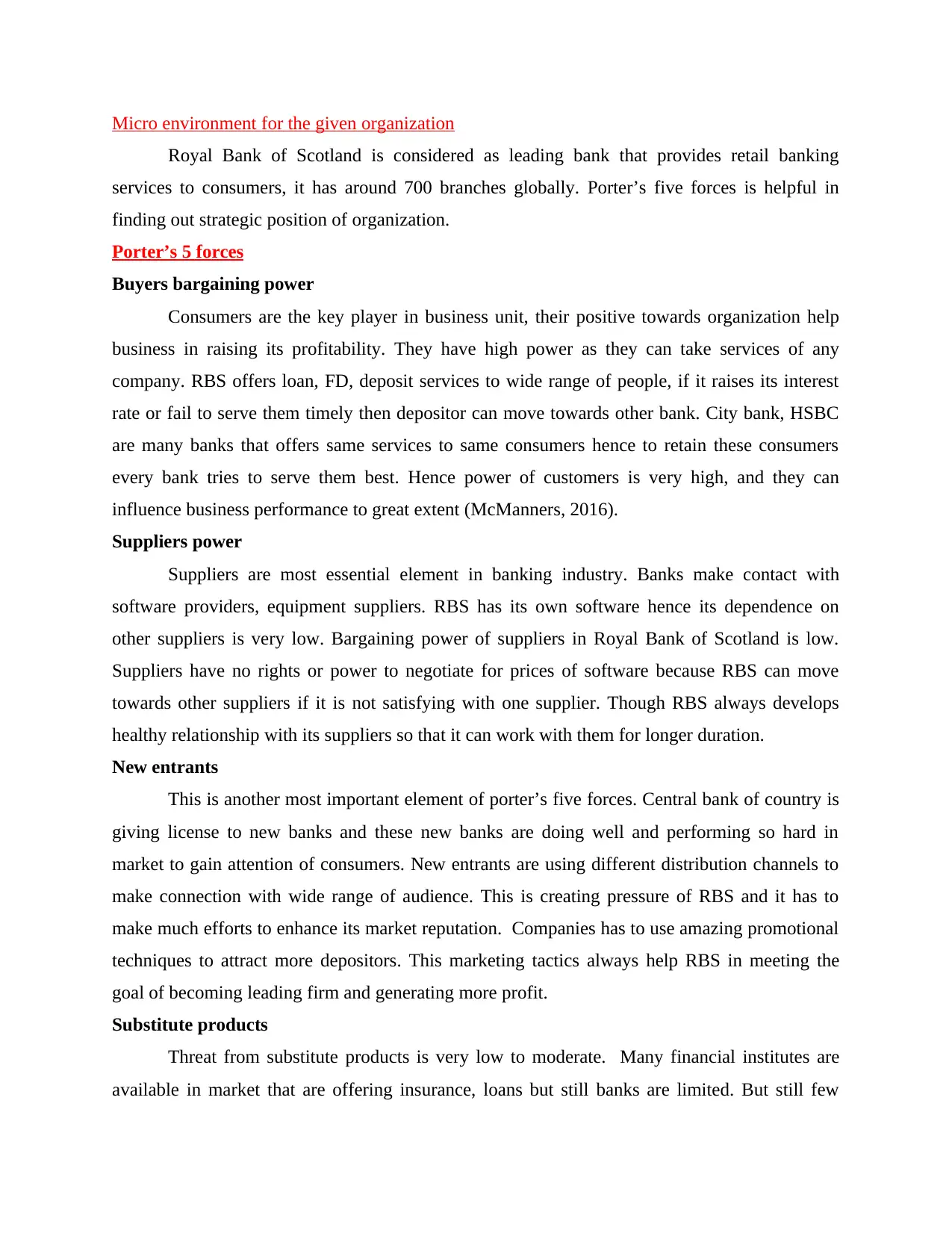
Micro environment for the given organization
Royal Bank of Scotland is considered as leading bank that provides retail banking
services to consumers, it has around 700 branches globally. Porter’s five forces is helpful in
finding out strategic position of organization.
Porter’s 5 forces
Buyers bargaining power
Consumers are the key player in business unit, their positive towards organization help
business in raising its profitability. They have high power as they can take services of any
company. RBS offers loan, FD, deposit services to wide range of people, if it raises its interest
rate or fail to serve them timely then depositor can move towards other bank. City bank, HSBC
are many banks that offers same services to same consumers hence to retain these consumers
every bank tries to serve them best. Hence power of customers is very high, and they can
influence business performance to great extent (McManners, 2016).
Suppliers power
Suppliers are most essential element in banking industry. Banks make contact with
software providers, equipment suppliers. RBS has its own software hence its dependence on
other suppliers is very low. Bargaining power of suppliers in Royal Bank of Scotland is low.
Suppliers have no rights or power to negotiate for prices of software because RBS can move
towards other suppliers if it is not satisfying with one supplier. Though RBS always develops
healthy relationship with its suppliers so that it can work with them for longer duration.
New entrants
This is another most important element of porter’s five forces. Central bank of country is
giving license to new banks and these new banks are doing well and performing so hard in
market to gain attention of consumers. New entrants are using different distribution channels to
make connection with wide range of audience. This is creating pressure of RBS and it has to
make much efforts to enhance its market reputation. Companies has to use amazing promotional
techniques to attract more depositors. This marketing tactics always help RBS in meeting the
goal of becoming leading firm and generating more profit.
Substitute products
Threat from substitute products is very low to moderate. Many financial institutes are
available in market that are offering insurance, loans but still banks are limited. But still few
Royal Bank of Scotland is considered as leading bank that provides retail banking
services to consumers, it has around 700 branches globally. Porter’s five forces is helpful in
finding out strategic position of organization.
Porter’s 5 forces
Buyers bargaining power
Consumers are the key player in business unit, their positive towards organization help
business in raising its profitability. They have high power as they can take services of any
company. RBS offers loan, FD, deposit services to wide range of people, if it raises its interest
rate or fail to serve them timely then depositor can move towards other bank. City bank, HSBC
are many banks that offers same services to same consumers hence to retain these consumers
every bank tries to serve them best. Hence power of customers is very high, and they can
influence business performance to great extent (McManners, 2016).
Suppliers power
Suppliers are most essential element in banking industry. Banks make contact with
software providers, equipment suppliers. RBS has its own software hence its dependence on
other suppliers is very low. Bargaining power of suppliers in Royal Bank of Scotland is low.
Suppliers have no rights or power to negotiate for prices of software because RBS can move
towards other suppliers if it is not satisfying with one supplier. Though RBS always develops
healthy relationship with its suppliers so that it can work with them for longer duration.
New entrants
This is another most important element of porter’s five forces. Central bank of country is
giving license to new banks and these new banks are doing well and performing so hard in
market to gain attention of consumers. New entrants are using different distribution channels to
make connection with wide range of audience. This is creating pressure of RBS and it has to
make much efforts to enhance its market reputation. Companies has to use amazing promotional
techniques to attract more depositors. This marketing tactics always help RBS in meeting the
goal of becoming leading firm and generating more profit.
Substitute products
Threat from substitute products is very low to moderate. Many financial institutes are
available in market that are offering insurance, loans but still banks are limited. But still few
Paraphrase This Document
Need a fresh take? Get an instant paraphrase of this document with our AI Paraphraser
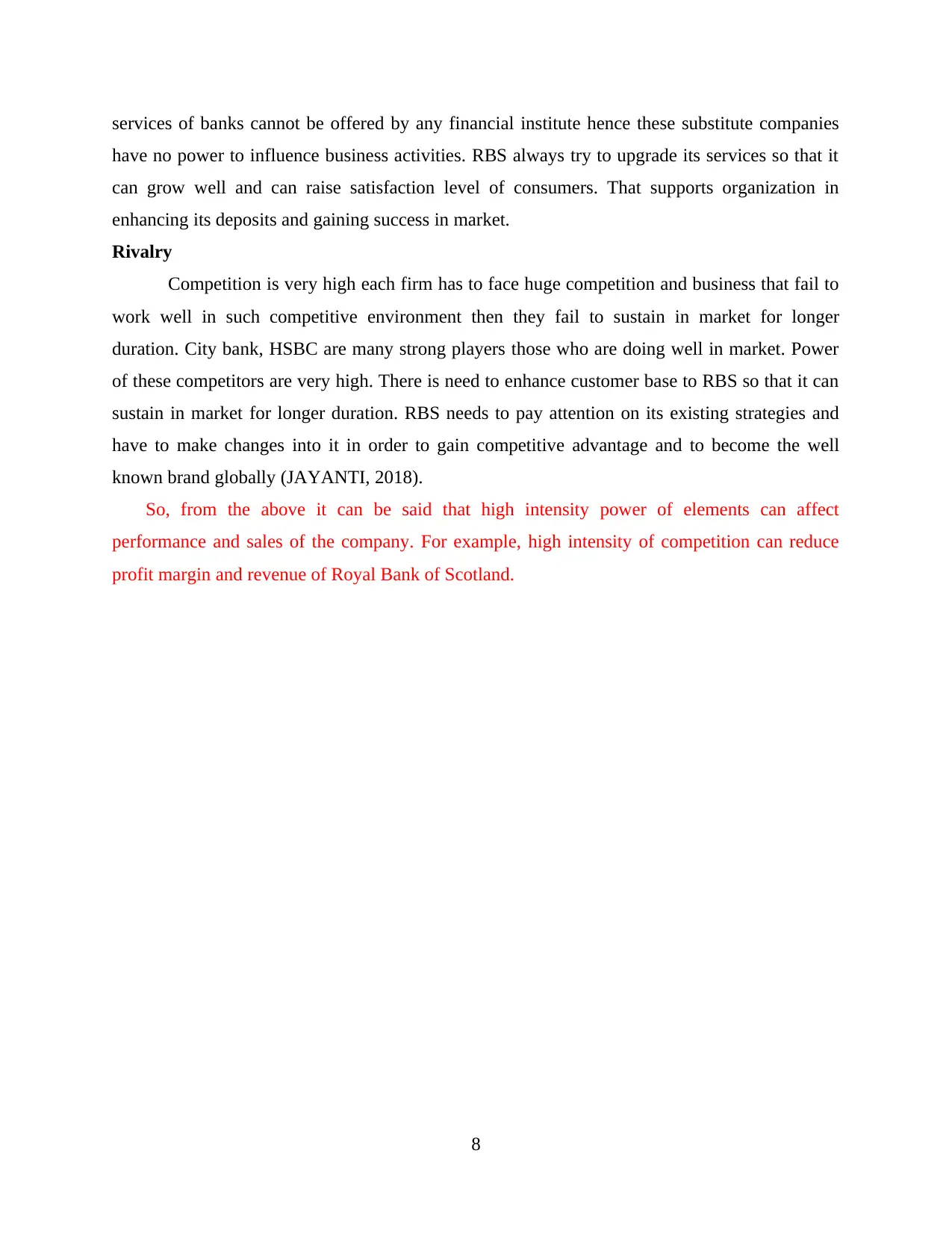
services of banks cannot be offered by any financial institute hence these substitute companies
have no power to influence business activities. RBS always try to upgrade its services so that it
can grow well and can raise satisfaction level of consumers. That supports organization in
enhancing its deposits and gaining success in market.
Rivalry
Competition is very high each firm has to face huge competition and business that fail to
work well in such competitive environment then they fail to sustain in market for longer
duration. City bank, HSBC are many strong players those who are doing well in market. Power
of these competitors are very high. There is need to enhance customer base to RBS so that it can
sustain in market for longer duration. RBS needs to pay attention on its existing strategies and
have to make changes into it in order to gain competitive advantage and to become the well
known brand globally (JAYANTI, 2018).
So, from the above it can be said that high intensity power of elements can affect
performance and sales of the company. For example, high intensity of competition can reduce
profit margin and revenue of Royal Bank of Scotland.
8
have no power to influence business activities. RBS always try to upgrade its services so that it
can grow well and can raise satisfaction level of consumers. That supports organization in
enhancing its deposits and gaining success in market.
Rivalry
Competition is very high each firm has to face huge competition and business that fail to
work well in such competitive environment then they fail to sustain in market for longer
duration. City bank, HSBC are many strong players those who are doing well in market. Power
of these competitors are very high. There is need to enhance customer base to RBS so that it can
sustain in market for longer duration. RBS needs to pay attention on its existing strategies and
have to make changes into it in order to gain competitive advantage and to become the well
known brand globally (JAYANTI, 2018).
So, from the above it can be said that high intensity power of elements can affect
performance and sales of the company. For example, high intensity of competition can reduce
profit margin and revenue of Royal Bank of Scotland.
8
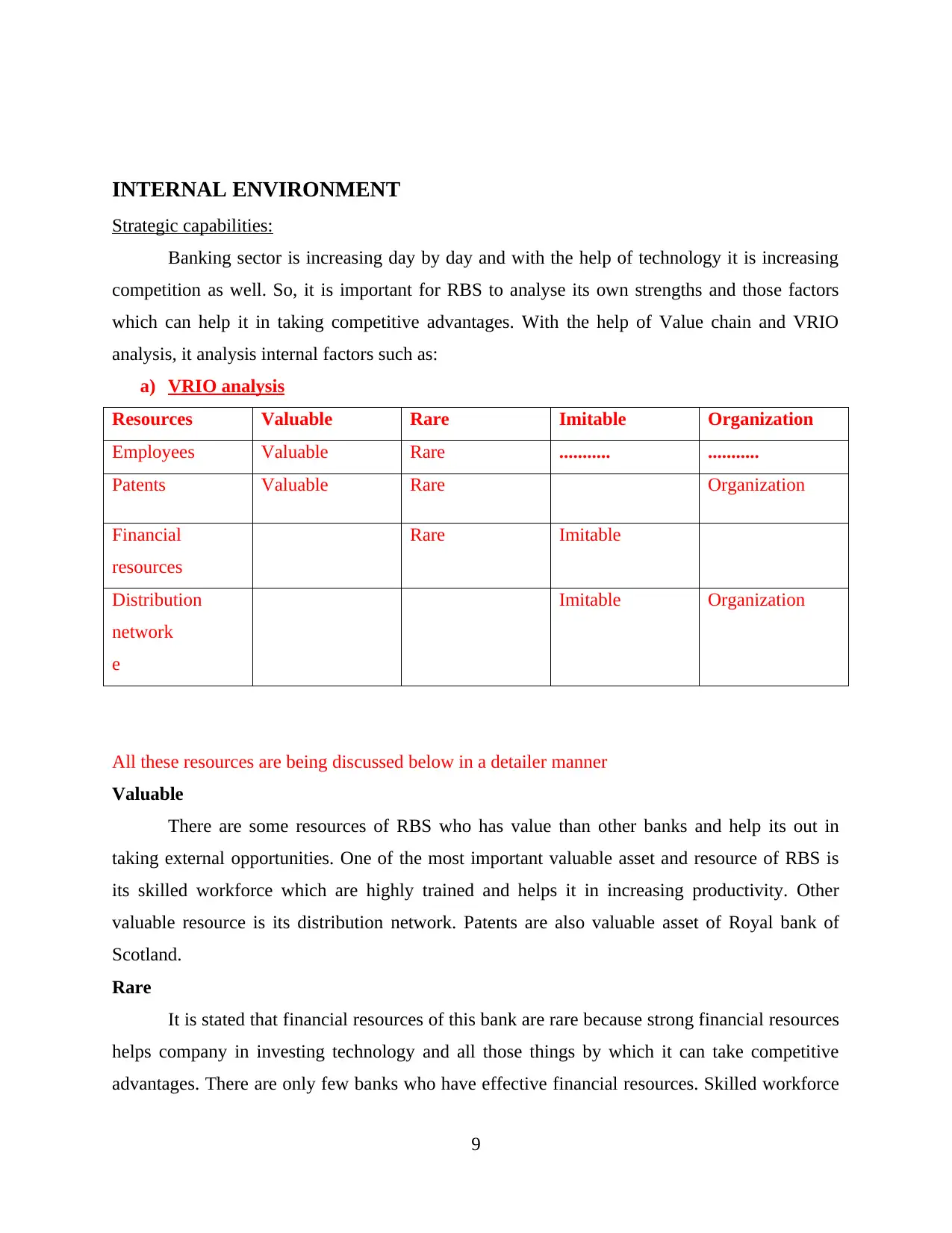
INTERNAL ENVIRONMENT
Strategic capabilities:
Banking sector is increasing day by day and with the help of technology it is increasing
competition as well. So, it is important for RBS to analyse its own strengths and those factors
which can help it in taking competitive advantages. With the help of Value chain and VRIO
analysis, it analysis internal factors such as:
a) VRIO analysis
Resources Valuable Rare Imitable Organization
Employees Valuable Rare ........... ...........
Patents Valuable Rare Organization
Financial
resources
Rare Imitable
Distribution
network
e
Imitable Organization
All these resources are being discussed below in a detailer manner
Valuable
There are some resources of RBS who has value than other banks and help its out in
taking external opportunities. One of the most important valuable asset and resource of RBS is
its skilled workforce which are highly trained and helps it in increasing productivity. Other
valuable resource is its distribution network. Patents are also valuable asset of Royal bank of
Scotland.
Rare
It is stated that financial resources of this bank are rare because strong financial resources
helps company in investing technology and all those things by which it can take competitive
advantages. There are only few banks who have effective financial resources. Skilled workforce
9
Strategic capabilities:
Banking sector is increasing day by day and with the help of technology it is increasing
competition as well. So, it is important for RBS to analyse its own strengths and those factors
which can help it in taking competitive advantages. With the help of Value chain and VRIO
analysis, it analysis internal factors such as:
a) VRIO analysis
Resources Valuable Rare Imitable Organization
Employees Valuable Rare ........... ...........
Patents Valuable Rare Organization
Financial
resources
Rare Imitable
Distribution
network
e
Imitable Organization
All these resources are being discussed below in a detailer manner
Valuable
There are some resources of RBS who has value than other banks and help its out in
taking external opportunities. One of the most important valuable asset and resource of RBS is
its skilled workforce which are highly trained and helps it in increasing productivity. Other
valuable resource is its distribution network. Patents are also valuable asset of Royal bank of
Scotland.
Rare
It is stated that financial resources of this bank are rare because strong financial resources
helps company in investing technology and all those things by which it can take competitive
advantages. There are only few banks who have effective financial resources. Skilled workforce
9
⊘ This is a preview!⊘
Do you want full access?
Subscribe today to unlock all pages.

Trusted by 1+ million students worldwide
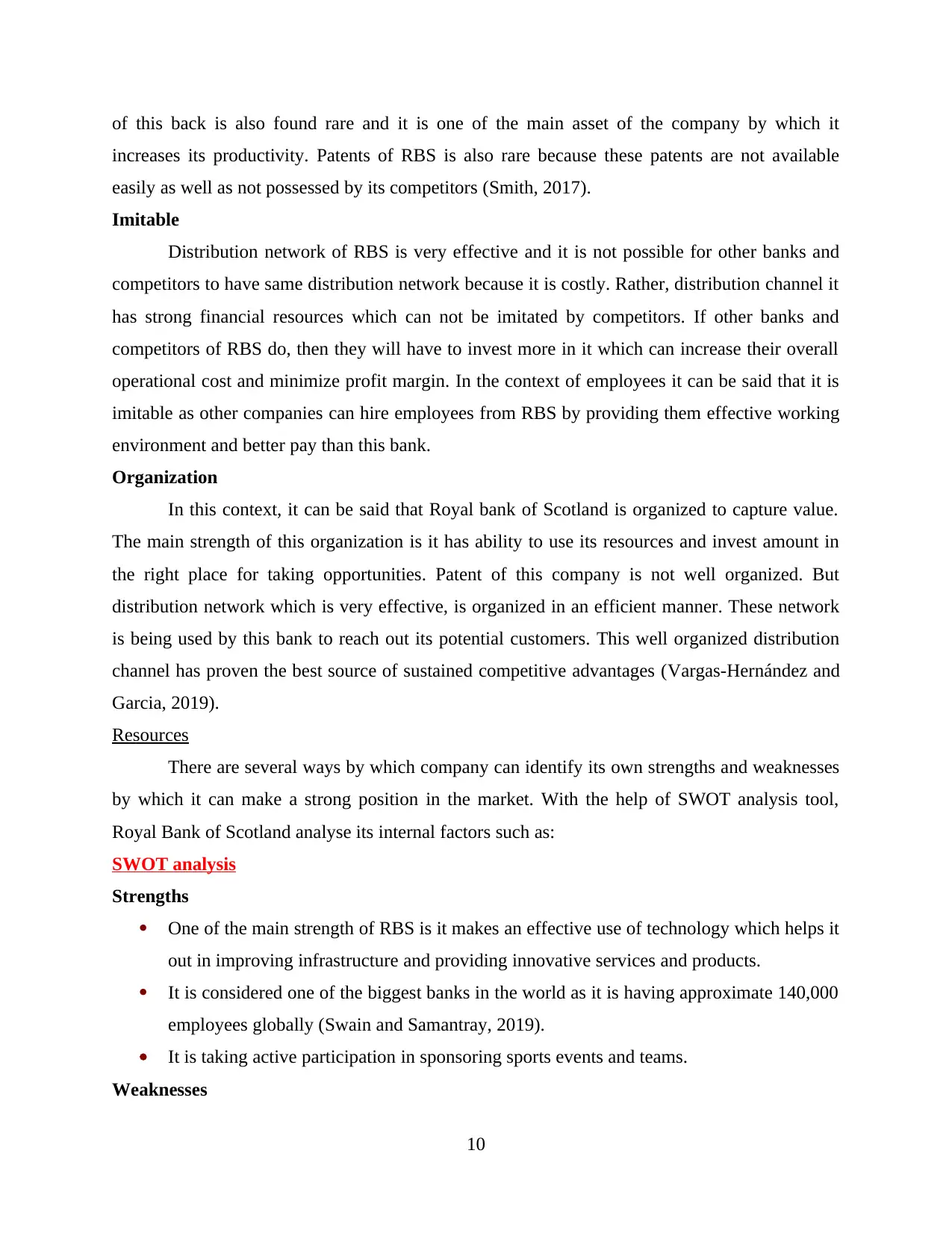
of this back is also found rare and it is one of the main asset of the company by which it
increases its productivity. Patents of RBS is also rare because these patents are not available
easily as well as not possessed by its competitors (Smith, 2017).
Imitable
Distribution network of RBS is very effective and it is not possible for other banks and
competitors to have same distribution network because it is costly. Rather, distribution channel it
has strong financial resources which can not be imitated by competitors. If other banks and
competitors of RBS do, then they will have to invest more in it which can increase their overall
operational cost and minimize profit margin. In the context of employees it can be said that it is
imitable as other companies can hire employees from RBS by providing them effective working
environment and better pay than this bank.
Organization
In this context, it can be said that Royal bank of Scotland is organized to capture value.
The main strength of this organization is it has ability to use its resources and invest amount in
the right place for taking opportunities. Patent of this company is not well organized. But
distribution network which is very effective, is organized in an efficient manner. These network
is being used by this bank to reach out its potential customers. This well organized distribution
channel has proven the best source of sustained competitive advantages (Vargas-Hernández and
Garcia, 2019).
Resources
There are several ways by which company can identify its own strengths and weaknesses
by which it can make a strong position in the market. With the help of SWOT analysis tool,
Royal Bank of Scotland analyse its internal factors such as:
SWOT analysis
Strengths
One of the main strength of RBS is it makes an effective use of technology which helps it
out in improving infrastructure and providing innovative services and products.
It is considered one of the biggest banks in the world as it is having approximate 140,000
employees globally (Swain and Samantray, 2019).
It is taking active participation in sponsoring sports events and teams.
Weaknesses
10
increases its productivity. Patents of RBS is also rare because these patents are not available
easily as well as not possessed by its competitors (Smith, 2017).
Imitable
Distribution network of RBS is very effective and it is not possible for other banks and
competitors to have same distribution network because it is costly. Rather, distribution channel it
has strong financial resources which can not be imitated by competitors. If other banks and
competitors of RBS do, then they will have to invest more in it which can increase their overall
operational cost and minimize profit margin. In the context of employees it can be said that it is
imitable as other companies can hire employees from RBS by providing them effective working
environment and better pay than this bank.
Organization
In this context, it can be said that Royal bank of Scotland is organized to capture value.
The main strength of this organization is it has ability to use its resources and invest amount in
the right place for taking opportunities. Patent of this company is not well organized. But
distribution network which is very effective, is organized in an efficient manner. These network
is being used by this bank to reach out its potential customers. This well organized distribution
channel has proven the best source of sustained competitive advantages (Vargas-Hernández and
Garcia, 2019).
Resources
There are several ways by which company can identify its own strengths and weaknesses
by which it can make a strong position in the market. With the help of SWOT analysis tool,
Royal Bank of Scotland analyse its internal factors such as:
SWOT analysis
Strengths
One of the main strength of RBS is it makes an effective use of technology which helps it
out in improving infrastructure and providing innovative services and products.
It is considered one of the biggest banks in the world as it is having approximate 140,000
employees globally (Swain and Samantray, 2019).
It is taking active participation in sponsoring sports events and teams.
Weaknesses
10
Paraphrase This Document
Need a fresh take? Get an instant paraphrase of this document with our AI Paraphraser
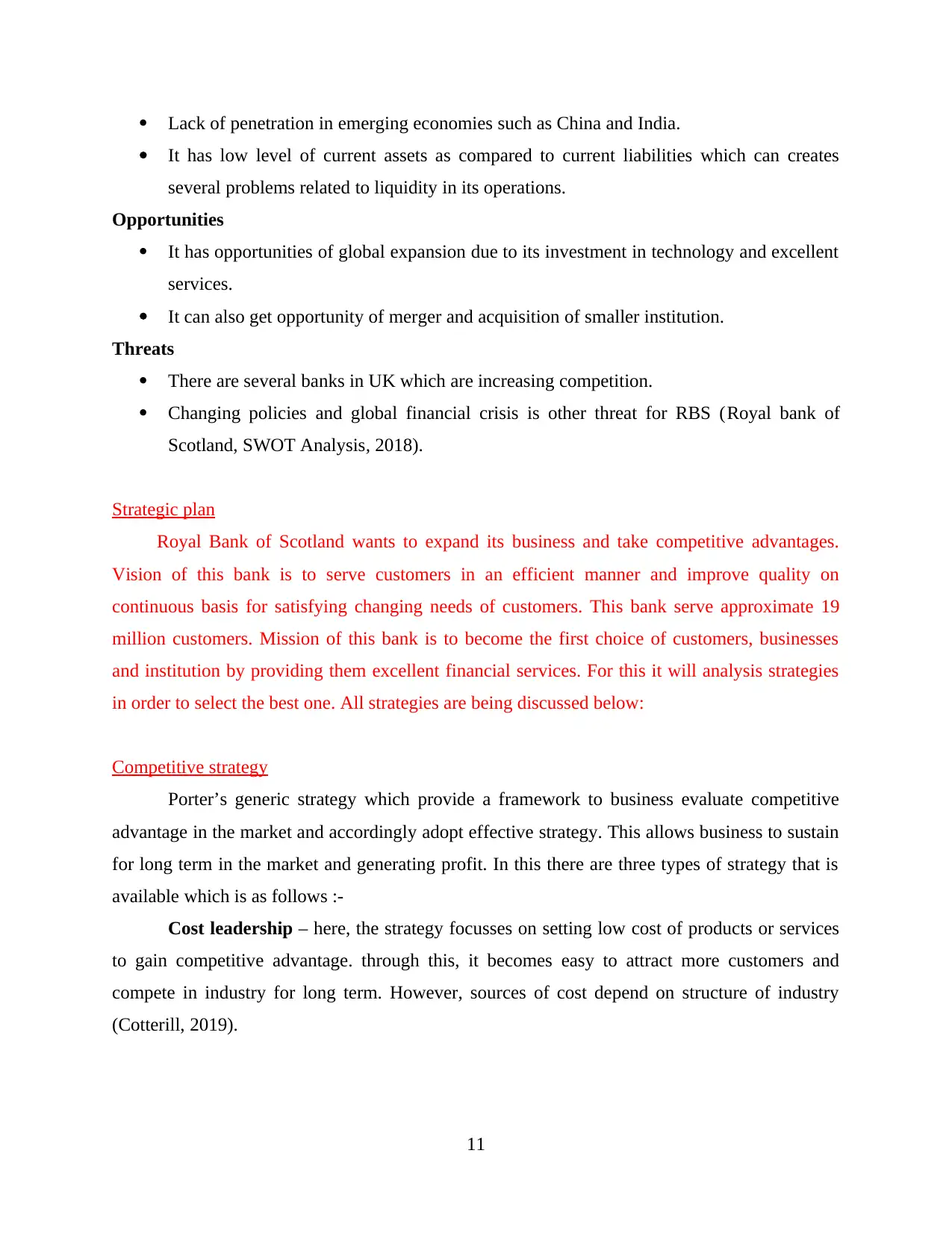
Lack of penetration in emerging economies such as China and India.
It has low level of current assets as compared to current liabilities which can creates
several problems related to liquidity in its operations.
Opportunities
It has opportunities of global expansion due to its investment in technology and excellent
services.
It can also get opportunity of merger and acquisition of smaller institution.
Threats
There are several banks in UK which are increasing competition.
Changing policies and global financial crisis is other threat for RBS (Royal bank of
Scotland, SWOT Analysis, 2018).
Strategic plan
Royal Bank of Scotland wants to expand its business and take competitive advantages.
Vision of this bank is to serve customers in an efficient manner and improve quality on
continuous basis for satisfying changing needs of customers. This bank serve approximate 19
million customers. Mission of this bank is to become the first choice of customers, businesses
and institution by providing them excellent financial services. For this it will analysis strategies
in order to select the best one. All strategies are being discussed below:
Competitive strategy
Porter’s generic strategy which provide a framework to business evaluate competitive
advantage in the market and accordingly adopt effective strategy. This allows business to sustain
for long term in the market and generating profit. In this there are three types of strategy that is
available which is as follows :-
Cost leadership – here, the strategy focusses on setting low cost of products or services
to gain competitive advantage. through this, it becomes easy to attract more customers and
compete in industry for long term. However, sources of cost depend on structure of industry
(Cotterill, 2019).
11
It has low level of current assets as compared to current liabilities which can creates
several problems related to liquidity in its operations.
Opportunities
It has opportunities of global expansion due to its investment in technology and excellent
services.
It can also get opportunity of merger and acquisition of smaller institution.
Threats
There are several banks in UK which are increasing competition.
Changing policies and global financial crisis is other threat for RBS (Royal bank of
Scotland, SWOT Analysis, 2018).
Strategic plan
Royal Bank of Scotland wants to expand its business and take competitive advantages.
Vision of this bank is to serve customers in an efficient manner and improve quality on
continuous basis for satisfying changing needs of customers. This bank serve approximate 19
million customers. Mission of this bank is to become the first choice of customers, businesses
and institution by providing them excellent financial services. For this it will analysis strategies
in order to select the best one. All strategies are being discussed below:
Competitive strategy
Porter’s generic strategy which provide a framework to business evaluate competitive
advantage in the market and accordingly adopt effective strategy. This allows business to sustain
for long term in the market and generating profit. In this there are three types of strategy that is
available which is as follows :-
Cost leadership – here, the strategy focusses on setting low cost of products or services
to gain competitive advantage. through this, it becomes easy to attract more customers and
compete in industry for long term. However, sources of cost depend on structure of industry
(Cotterill, 2019).
11
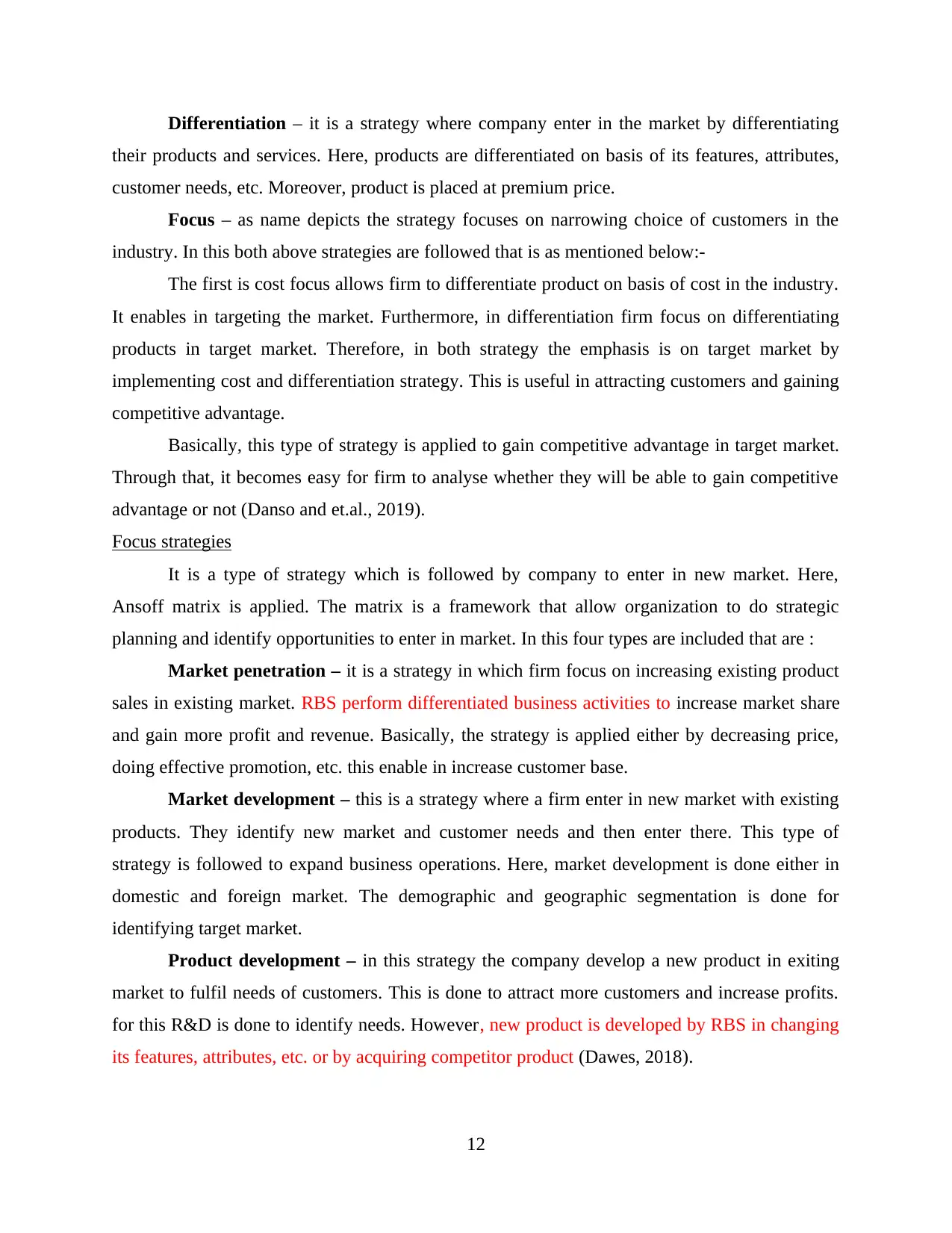
Differentiation – it is a strategy where company enter in the market by differentiating
their products and services. Here, products are differentiated on basis of its features, attributes,
customer needs, etc. Moreover, product is placed at premium price.
Focus – as name depicts the strategy focuses on narrowing choice of customers in the
industry. In this both above strategies are followed that is as mentioned below:-
The first is cost focus allows firm to differentiate product on basis of cost in the industry.
It enables in targeting the market. Furthermore, in differentiation firm focus on differentiating
products in target market. Therefore, in both strategy the emphasis is on target market by
implementing cost and differentiation strategy. This is useful in attracting customers and gaining
competitive advantage.
Basically, this type of strategy is applied to gain competitive advantage in target market.
Through that, it becomes easy for firm to analyse whether they will be able to gain competitive
advantage or not (Danso and et.al., 2019).
Focus strategies
It is a type of strategy which is followed by company to enter in new market. Here,
Ansoff matrix is applied. The matrix is a framework that allow organization to do strategic
planning and identify opportunities to enter in market. In this four types are included that are :
Market penetration – it is a strategy in which firm focus on increasing existing product
sales in existing market. RBS perform differentiated business activities to increase market share
and gain more profit and revenue. Basically, the strategy is applied either by decreasing price,
doing effective promotion, etc. this enable in increase customer base.
Market development – this is a strategy where a firm enter in new market with existing
products. They identify new market and customer needs and then enter there. This type of
strategy is followed to expand business operations. Here, market development is done either in
domestic and foreign market. The demographic and geographic segmentation is done for
identifying target market.
Product development – in this strategy the company develop a new product in exiting
market to fulfil needs of customers. This is done to attract more customers and increase profits.
for this R&D is done to identify needs. However, new product is developed by RBS in changing
its features, attributes, etc. or by acquiring competitor product (Dawes, 2018).
12
their products and services. Here, products are differentiated on basis of its features, attributes,
customer needs, etc. Moreover, product is placed at premium price.
Focus – as name depicts the strategy focuses on narrowing choice of customers in the
industry. In this both above strategies are followed that is as mentioned below:-
The first is cost focus allows firm to differentiate product on basis of cost in the industry.
It enables in targeting the market. Furthermore, in differentiation firm focus on differentiating
products in target market. Therefore, in both strategy the emphasis is on target market by
implementing cost and differentiation strategy. This is useful in attracting customers and gaining
competitive advantage.
Basically, this type of strategy is applied to gain competitive advantage in target market.
Through that, it becomes easy for firm to analyse whether they will be able to gain competitive
advantage or not (Danso and et.al., 2019).
Focus strategies
It is a type of strategy which is followed by company to enter in new market. Here,
Ansoff matrix is applied. The matrix is a framework that allow organization to do strategic
planning and identify opportunities to enter in market. In this four types are included that are :
Market penetration – it is a strategy in which firm focus on increasing existing product
sales in existing market. RBS perform differentiated business activities to increase market share
and gain more profit and revenue. Basically, the strategy is applied either by decreasing price,
doing effective promotion, etc. this enable in increase customer base.
Market development – this is a strategy where a firm enter in new market with existing
products. They identify new market and customer needs and then enter there. This type of
strategy is followed to expand business operations. Here, market development is done either in
domestic and foreign market. The demographic and geographic segmentation is done for
identifying target market.
Product development – in this strategy the company develop a new product in exiting
market to fulfil needs of customers. This is done to attract more customers and increase profits.
for this R&D is done to identify needs. However, new product is developed by RBS in changing
its features, attributes, etc. or by acquiring competitor product (Dawes, 2018).
12
⊘ This is a preview!⊘
Do you want full access?
Subscribe today to unlock all pages.

Trusted by 1+ million students worldwide
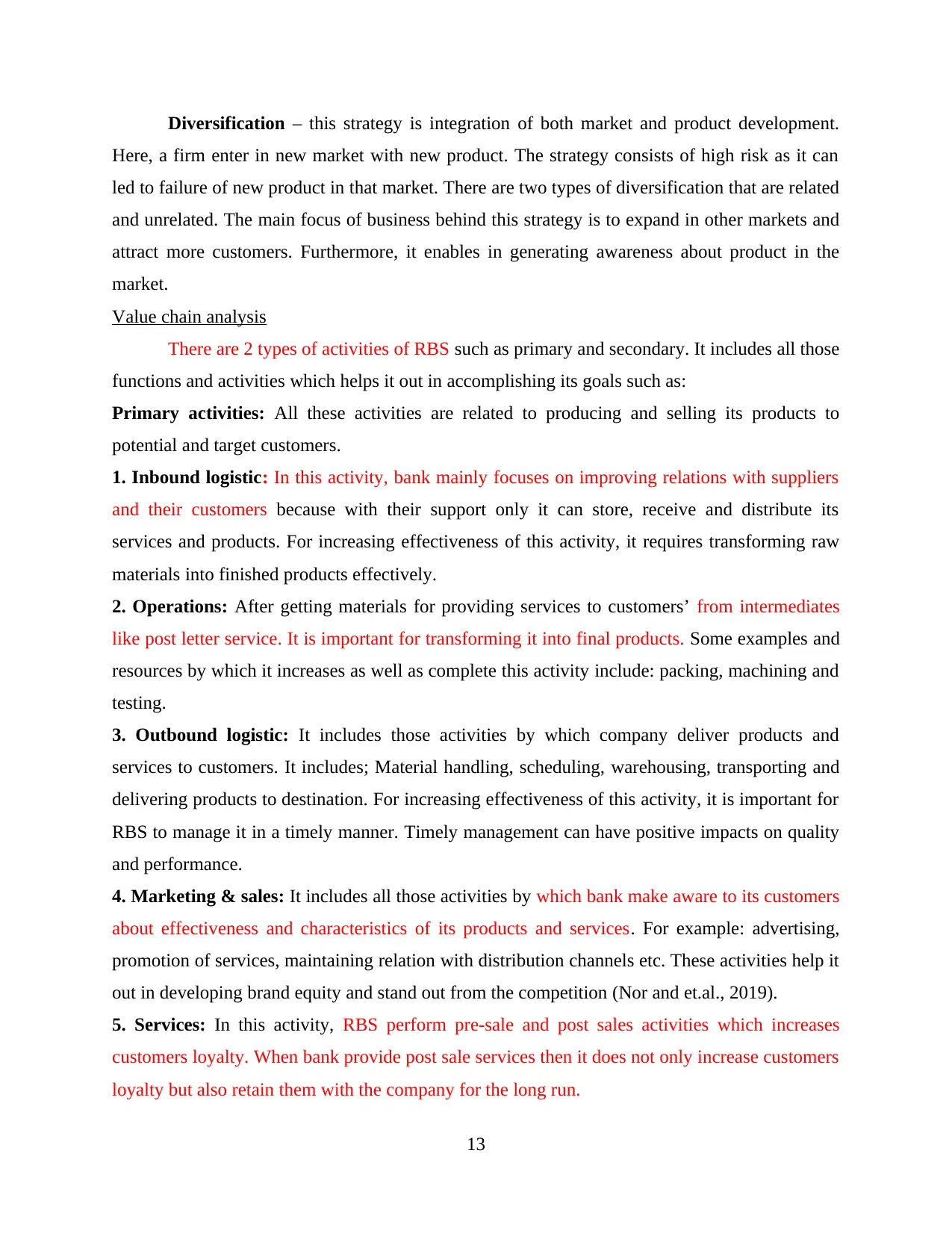
Diversification – this strategy is integration of both market and product development.
Here, a firm enter in new market with new product. The strategy consists of high risk as it can
led to failure of new product in that market. There are two types of diversification that are related
and unrelated. The main focus of business behind this strategy is to expand in other markets and
attract more customers. Furthermore, it enables in generating awareness about product in the
market.
Value chain analysis
There are 2 types of activities of RBS such as primary and secondary. It includes all those
functions and activities which helps it out in accomplishing its goals such as:
Primary activities: All these activities are related to producing and selling its products to
potential and target customers.
1. Inbound logistic: In this activity, bank mainly focuses on improving relations with suppliers
and their customers because with their support only it can store, receive and distribute its
services and products. For increasing effectiveness of this activity, it requires transforming raw
materials into finished products effectively.
2. Operations: After getting materials for providing services to customers’ from intermediates
like post letter service. It is important for transforming it into final products. Some examples and
resources by which it increases as well as complete this activity include: packing, machining and
testing.
3. Outbound logistic: It includes those activities by which company deliver products and
services to customers. It includes; Material handling, scheduling, warehousing, transporting and
delivering products to destination. For increasing effectiveness of this activity, it is important for
RBS to manage it in a timely manner. Timely management can have positive impacts on quality
and performance.
4. Marketing & sales: It includes all those activities by which bank make aware to its customers
about effectiveness and characteristics of its products and services. For example: advertising,
promotion of services, maintaining relation with distribution channels etc. These activities help it
out in developing brand equity and stand out from the competition (Nor and et.al., 2019).
5. Services: In this activity, RBS perform pre-sale and post sales activities which increases
customers loyalty. When bank provide post sale services then it does not only increase customers
loyalty but also retain them with the company for the long run.
13
Here, a firm enter in new market with new product. The strategy consists of high risk as it can
led to failure of new product in that market. There are two types of diversification that are related
and unrelated. The main focus of business behind this strategy is to expand in other markets and
attract more customers. Furthermore, it enables in generating awareness about product in the
market.
Value chain analysis
There are 2 types of activities of RBS such as primary and secondary. It includes all those
functions and activities which helps it out in accomplishing its goals such as:
Primary activities: All these activities are related to producing and selling its products to
potential and target customers.
1. Inbound logistic: In this activity, bank mainly focuses on improving relations with suppliers
and their customers because with their support only it can store, receive and distribute its
services and products. For increasing effectiveness of this activity, it requires transforming raw
materials into finished products effectively.
2. Operations: After getting materials for providing services to customers’ from intermediates
like post letter service. It is important for transforming it into final products. Some examples and
resources by which it increases as well as complete this activity include: packing, machining and
testing.
3. Outbound logistic: It includes those activities by which company deliver products and
services to customers. It includes; Material handling, scheduling, warehousing, transporting and
delivering products to destination. For increasing effectiveness of this activity, it is important for
RBS to manage it in a timely manner. Timely management can have positive impacts on quality
and performance.
4. Marketing & sales: It includes all those activities by which bank make aware to its customers
about effectiveness and characteristics of its products and services. For example: advertising,
promotion of services, maintaining relation with distribution channels etc. These activities help it
out in developing brand equity and stand out from the competition (Nor and et.al., 2019).
5. Services: In this activity, RBS perform pre-sale and post sales activities which increases
customers loyalty. When bank provide post sale services then it does not only increase customers
loyalty but also retain them with the company for the long run.
13
Paraphrase This Document
Need a fresh take? Get an instant paraphrase of this document with our AI Paraphraser

Secondary activities: It is considered as supportive activities which include:
1. Infrastructure: It includes those activities which helps it out in improving quality of products
and services such as financing, quality management, accounting etc.
2. HRM: It is considered supportive activity but helps it out in getting effective workforce which
is the main key of the success. HRM include: recruitment, selection, training, rewarding and
other workforce management activities.
3. Technology development: There are several sectors who are making an effective use of
technology. Banking sector is one of them. This activity of RBS include: technology integration
in marketing, distribution and production. Automation software and product design research are
some examples of it.
4. Procurement: It includes all those activities or materials which help it out in changing raw
materials in finished products. Raw material, machinery, HR and other tools are examples of it.
Recommendation of the best strategy
In order to grow and develop in the market and to sustain for long term Royal bank of
Scotland needs to follow and develop a specific strategy. This is because it will allow them to
compete in the market and generate more revenue. Thus, Royal bank of Scotland can focus on
market development strategy. Here, they can enter in new market such as countries of Europe
and other cities of UK. Through this, they will be able to attract new customers and provide
banking services in that markets. Moreover, by providing financial services more profits will be
gained. However, Royal Bank of Scotland will be able to increase customers base in those
markets. Also, as bank is already having a strong brand name it will be easy to attract customers.
CONCLUSION
From the above study, it has been summarized that business strategies played a vital role
for banking sector as it helped them in accomplishing their goals. There are several factors
involved in internal and external business environment which has both positive and negative
impacts on the performance and growth of an organization. With the help of PESTLE, Porter's 5
forces and SWOT analysis, banking sector and all banks analyse all factors and their impacts for
making changes in its own strategies and increasing strengths accordingly. With the help of
SWOT analysis, organization analysis internal factors like its own strengths and weaknesses in
order to decrease weaknesses and increasing strengths. Porter's 5 forces analysis also helped
14
1. Infrastructure: It includes those activities which helps it out in improving quality of products
and services such as financing, quality management, accounting etc.
2. HRM: It is considered supportive activity but helps it out in getting effective workforce which
is the main key of the success. HRM include: recruitment, selection, training, rewarding and
other workforce management activities.
3. Technology development: There are several sectors who are making an effective use of
technology. Banking sector is one of them. This activity of RBS include: technology integration
in marketing, distribution and production. Automation software and product design research are
some examples of it.
4. Procurement: It includes all those activities or materials which help it out in changing raw
materials in finished products. Raw material, machinery, HR and other tools are examples of it.
Recommendation of the best strategy
In order to grow and develop in the market and to sustain for long term Royal bank of
Scotland needs to follow and develop a specific strategy. This is because it will allow them to
compete in the market and generate more revenue. Thus, Royal bank of Scotland can focus on
market development strategy. Here, they can enter in new market such as countries of Europe
and other cities of UK. Through this, they will be able to attract new customers and provide
banking services in that markets. Moreover, by providing financial services more profits will be
gained. However, Royal Bank of Scotland will be able to increase customers base in those
markets. Also, as bank is already having a strong brand name it will be easy to attract customers.
CONCLUSION
From the above study, it has been summarized that business strategies played a vital role
for banking sector as it helped them in accomplishing their goals. There are several factors
involved in internal and external business environment which has both positive and negative
impacts on the performance and growth of an organization. With the help of PESTLE, Porter's 5
forces and SWOT analysis, banking sector and all banks analyse all factors and their impacts for
making changes in its own strategies and increasing strengths accordingly. With the help of
SWOT analysis, organization analysis internal factors like its own strengths and weaknesses in
order to decrease weaknesses and increasing strengths. Porter's 5 forces analysis also helped
14

bank in identifying intensity of competition in the banking industry for taking advantages of
competition.
This study has also shown effectiveness of focus and competitive strategies. Different
competitive strategies like cost leadership and differentiation has both positive and negative
impacts and by analysing in an efficient manner, company take decision to select the best one.
15
competition.
This study has also shown effectiveness of focus and competitive strategies. Different
competitive strategies like cost leadership and differentiation has both positive and negative
impacts and by analysing in an efficient manner, company take decision to select the best one.
15
⊘ This is a preview!⊘
Do you want full access?
Subscribe today to unlock all pages.

Trusted by 1+ million students worldwide
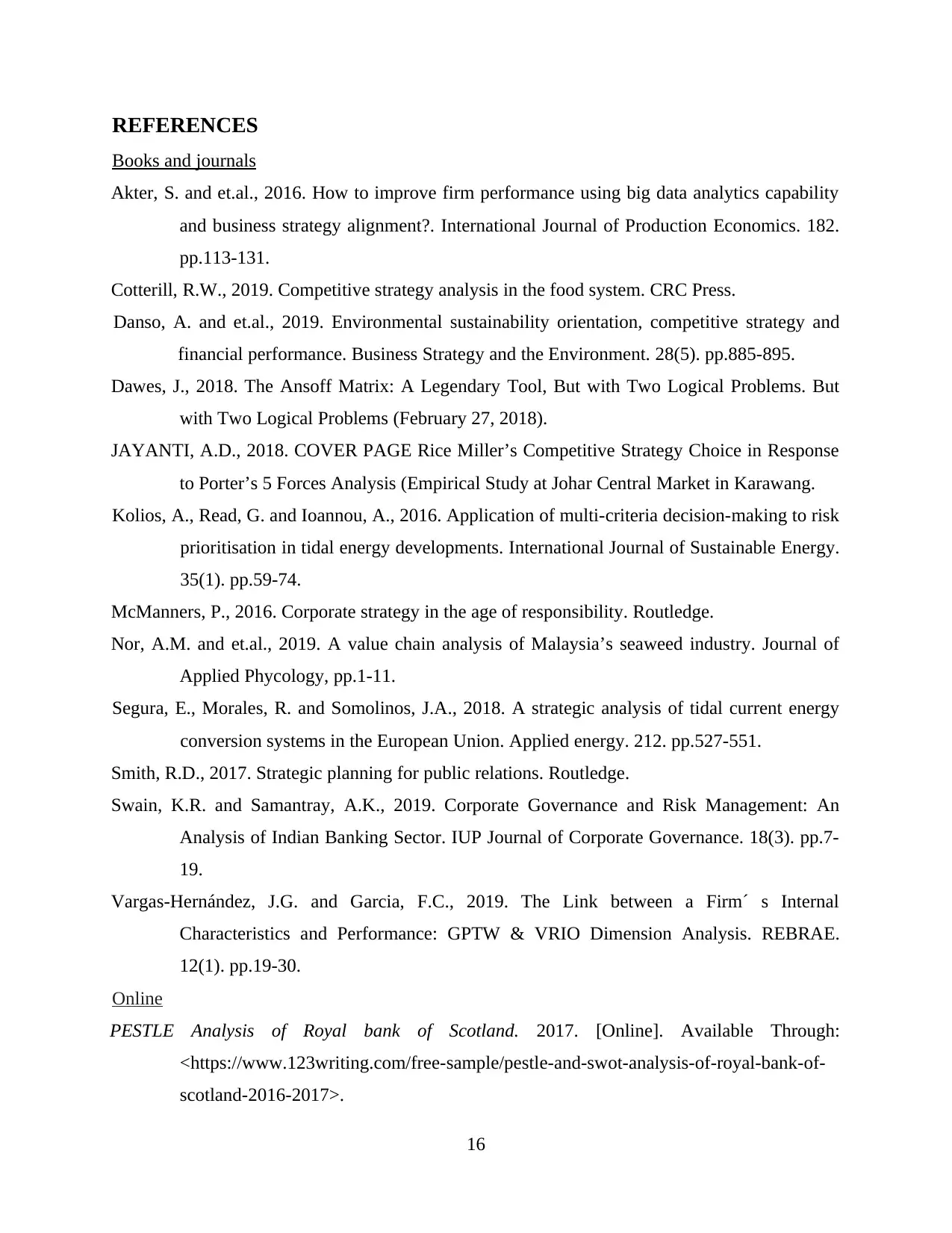
REFERENCES
Books and journals
Akter, S. and et.al., 2016. How to improve firm performance using big data analytics capability
and business strategy alignment?. International Journal of Production Economics. 182.
pp.113-131.
Cotterill, R.W., 2019. Competitive strategy analysis in the food system. CRC Press.
Danso, A. and et.al., 2019. Environmental sustainability orientation, competitive strategy and
financial performance. Business Strategy and the Environment. 28(5). pp.885-895.
Dawes, J., 2018. The Ansoff Matrix: A Legendary Tool, But with Two Logical Problems. But
with Two Logical Problems (February 27, 2018).
JAYANTI, A.D., 2018. COVER PAGE Rice Miller’s Competitive Strategy Choice in Response
to Porter’s 5 Forces Analysis (Empirical Study at Johar Central Market in Karawang.
Kolios, A., Read, G. and Ioannou, A., 2016. Application of multi-criteria decision-making to risk
prioritisation in tidal energy developments. International Journal of Sustainable Energy.
35(1). pp.59-74.
McManners, P., 2016. Corporate strategy in the age of responsibility. Routledge.
Nor, A.M. and et.al., 2019. A value chain analysis of Malaysia’s seaweed industry. Journal of
Applied Phycology, pp.1-11.
Segura, E., Morales, R. and Somolinos, J.A., 2018. A strategic analysis of tidal current energy
conversion systems in the European Union. Applied energy. 212. pp.527-551.
Smith, R.D., 2017. Strategic planning for public relations. Routledge.
Swain, K.R. and Samantray, A.K., 2019. Corporate Governance and Risk Management: An
Analysis of Indian Banking Sector. IUP Journal of Corporate Governance. 18(3). pp.7-
19.
Vargas-Hernández, J.G. and Garcia, F.C., 2019. The Link between a Firm´ s Internal
Characteristics and Performance: GPTW & VRIO Dimension Analysis. REBRAE.
12(1). pp.19-30.
Online
PESTLE Analysis of Royal bank of Scotland. 2017. [Online]. Available Through:
<https://www.123writing.com/free-sample/pestle-and-swot-analysis-of-royal-bank-of-
scotland-2016-2017>.
16
Books and journals
Akter, S. and et.al., 2016. How to improve firm performance using big data analytics capability
and business strategy alignment?. International Journal of Production Economics. 182.
pp.113-131.
Cotterill, R.W., 2019. Competitive strategy analysis in the food system. CRC Press.
Danso, A. and et.al., 2019. Environmental sustainability orientation, competitive strategy and
financial performance. Business Strategy and the Environment. 28(5). pp.885-895.
Dawes, J., 2018. The Ansoff Matrix: A Legendary Tool, But with Two Logical Problems. But
with Two Logical Problems (February 27, 2018).
JAYANTI, A.D., 2018. COVER PAGE Rice Miller’s Competitive Strategy Choice in Response
to Porter’s 5 Forces Analysis (Empirical Study at Johar Central Market in Karawang.
Kolios, A., Read, G. and Ioannou, A., 2016. Application of multi-criteria decision-making to risk
prioritisation in tidal energy developments. International Journal of Sustainable Energy.
35(1). pp.59-74.
McManners, P., 2016. Corporate strategy in the age of responsibility. Routledge.
Nor, A.M. and et.al., 2019. A value chain analysis of Malaysia’s seaweed industry. Journal of
Applied Phycology, pp.1-11.
Segura, E., Morales, R. and Somolinos, J.A., 2018. A strategic analysis of tidal current energy
conversion systems in the European Union. Applied energy. 212. pp.527-551.
Smith, R.D., 2017. Strategic planning for public relations. Routledge.
Swain, K.R. and Samantray, A.K., 2019. Corporate Governance and Risk Management: An
Analysis of Indian Banking Sector. IUP Journal of Corporate Governance. 18(3). pp.7-
19.
Vargas-Hernández, J.G. and Garcia, F.C., 2019. The Link between a Firm´ s Internal
Characteristics and Performance: GPTW & VRIO Dimension Analysis. REBRAE.
12(1). pp.19-30.
Online
PESTLE Analysis of Royal bank of Scotland. 2017. [Online]. Available Through:
<https://www.123writing.com/free-sample/pestle-and-swot-analysis-of-royal-bank-of-
scotland-2016-2017>.
16
Paraphrase This Document
Need a fresh take? Get an instant paraphrase of this document with our AI Paraphraser
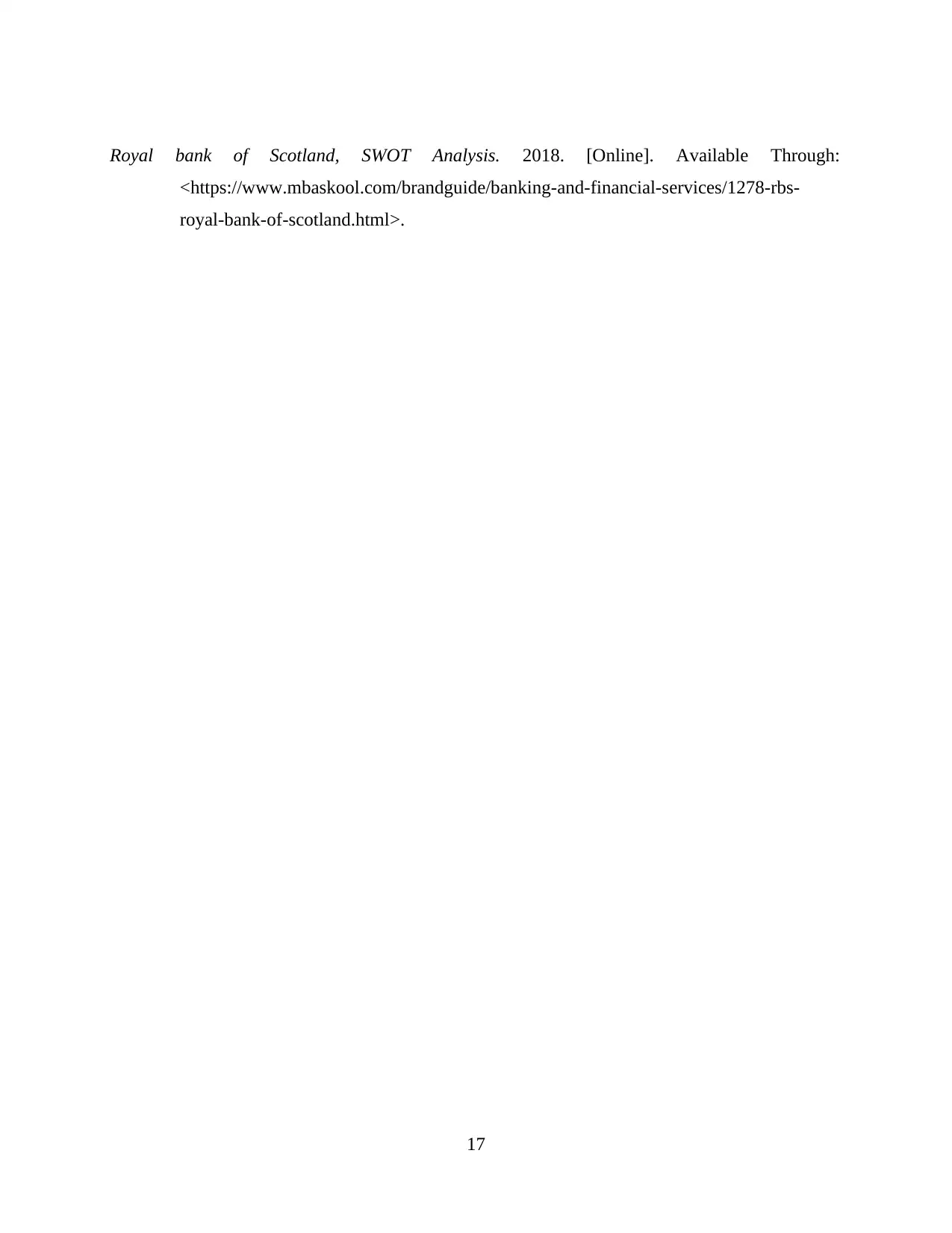
Royal bank of Scotland, SWOT Analysis. 2018. [Online]. Available Through:
<https://www.mbaskool.com/brandguide/banking-and-financial-services/1278-rbs-
royal-bank-of-scotland.html>.
17
<https://www.mbaskool.com/brandguide/banking-and-financial-services/1278-rbs-
royal-bank-of-scotland.html>.
17
1 out of 17
Related Documents
Your All-in-One AI-Powered Toolkit for Academic Success.
+13062052269
info@desklib.com
Available 24*7 on WhatsApp / Email
![[object Object]](/_next/static/media/star-bottom.7253800d.svg)
Unlock your academic potential
© 2024 | Zucol Services PVT LTD | All rights reserved.





